Not everyone has loamy soil that provides optimal growing conditions for any plant imaginable. Some people have clay soil, which can be harder for some plants to grow in.
If you have clay soil and live in Texas's dry, hot climate, anything you plant needs to survive with sometimes minimal water, especially considering that clay soil can "bake" in the summertime. That's why we've created this list of 11 plants that you can plant in clay soil in Texas.
For each of these plant suggestions, we'll also provide descriptions of the plants and any pertinent information that you need to know or consider when planting them. We'll also include pictures so that you can determine whether or not these plants are right for your landscaping or garden.
By choosing some of these groundcovers, flowering plants, and shrubs, you can still have beautiful plants that are adaptable to your clay soil and climate. Continue reading to learn more.

1. Texas Frogfruit (Phyla nodiflora)
Texas Frogfruit, sometimes called Turkey Tangle Frogfruit, is a perennial flowering groundcover plant in the Verbena family that can grow anywhere in the Southern U.S. This particular groundcover produces 3-6 inch tall white blooms in May-October.

But even when not in bloom, you'll be blessed with colorful green foliage as this is an evergreen plant in warm climates. In colder parts of Texas, the foliage may develop a red or purple tinge in the winter, but it will only go dormant during frigid weather.
Texas Frogfruit also requires low to medium water and is drought and heat-tolerant. It grows best in spots that receive sun or partial shade and when used as a border plant. This plant is also great for attracting butterflies to your garden, which is always a bonus.
2. Texas Sedge (Carex texensis)
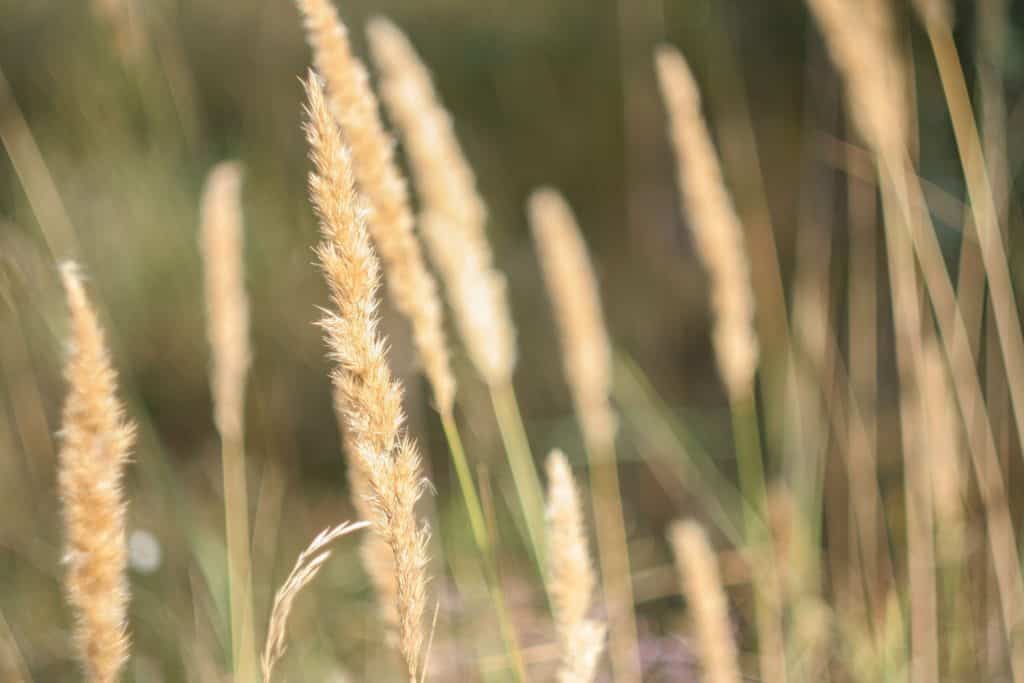
Texas Sedge is a type of perennial grass most common in central Texas. It's a great option if you're looking for grass to cover any bare spots in your lawn or garden. This grasses green foliage can reach 10-12 inches in height but can also be mowed using a high lawn mower setting if it gets too tall for your liking.
Although Texas Sedge loves sandy soil the best, it is highly adaptable to any soil type, including clay. The grass produces seeds during March-May, but like other grasses, it doesn't produce flowers. Texas Sedge is also heat-tolerant but thrives when planted in a sunny to a partially shady location and given a medium amount of water.
3. Pigeonberry (Rivina humilis)
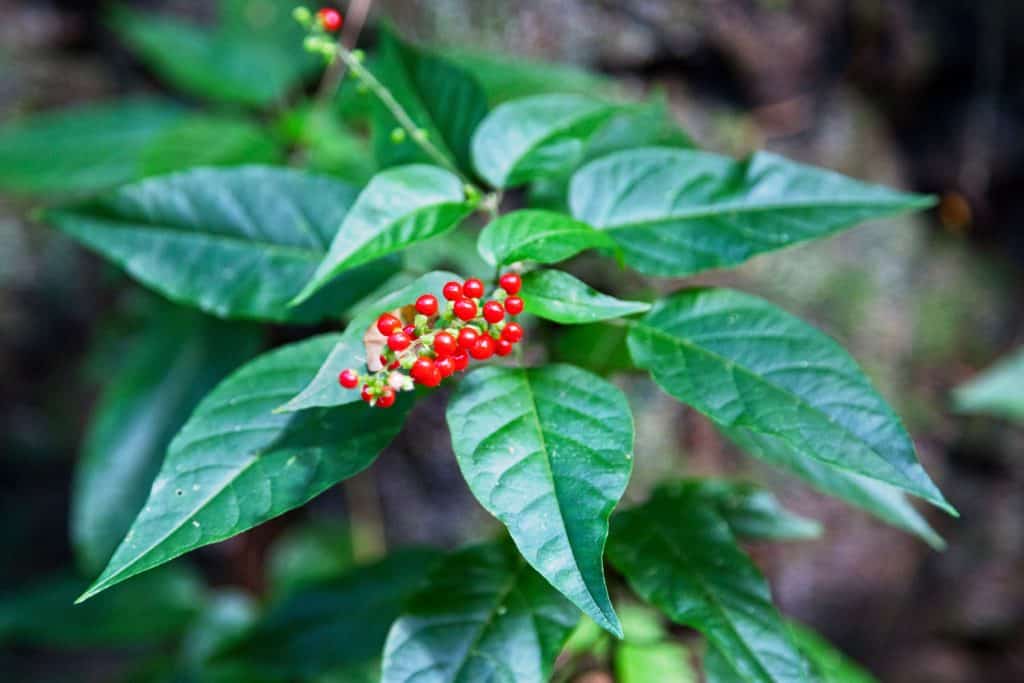
The Pigeonberry, also called Rouge Plant or Bloodberry, is a perennial herb part of the Pokeweed family. If you're looking for a plant that does well in clay soil and is shade-tolerant, this is a good choice because it can be grown even underneath trees and tall shrubs.
Pigeonberry plants do love moist soil, though, so you'll need to provide plenty of water in the summer months so that your herb doesn't go dormant. This plant species will also reach between 1-3 feet in height and produce pink and white flowers that turn into reddish-orange berries from March to October.
4. American Beautyberry (Callicarpa Americana)

American Beautyberry, also called French Mulberry, is a perennial shrub from the Verbena family. It requires little water and can grow in partial shade and clay soil. It's also both heat and cold-tolerant, making it perfect no matter which region of Texas you live in.
This shrub produces white and pink blooms throughout the summer (May-July) that turn into striking purple, pink, or white berries during the fall and winter. The leaves also change to yellow-green in fall before dropping to the ground, but the berries persist long afterward. American Beautyberry can also grow between three and five feet tall, which is great for creating walls of foliage.
5. Berlandier's Sundrops (Calylophus berlandieri)
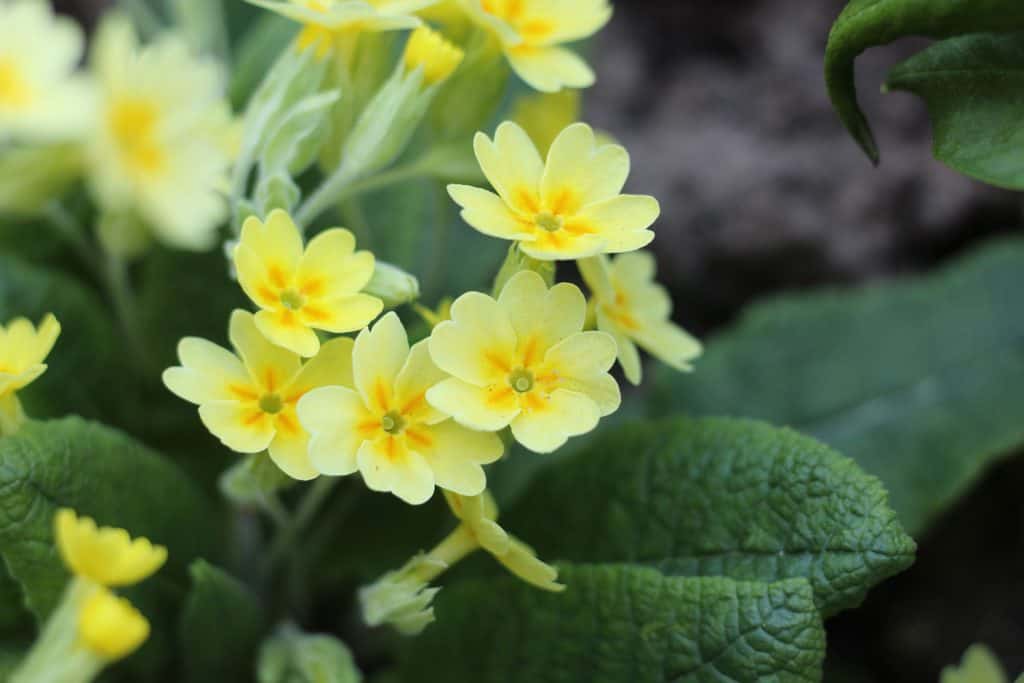
Berlandier's Sundrops are named after Jean Louis Berlandier, a scientist who collected plants in Texas and Mexico. This perennial flowering shrub is part of the Evening Primrose family and can grow up to 30 inches tall, although it isn't bushy like some shrubs.
Berlandier's Sundrops also has dark green foliage that produces yellow blooms in April-June. It requires little water and can grow in partial shade. It's best suited for the grassland and plains regions of Texas.
6. Rose Mallow (Pavonia lasiopetala)
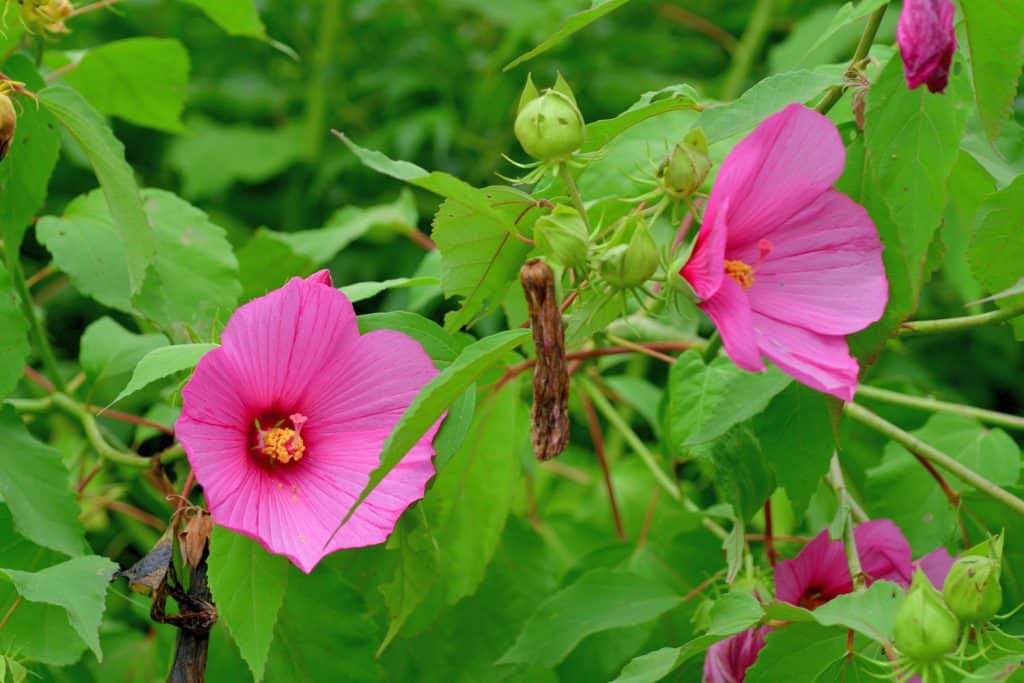
Rose Mallow or Rock Rose is a flowering shrub from the Mallow family. It's native throughout regions of central Texas down to Mexico, but it can grow anywhere in the state. This flowering shrub also prefers partial shade and requires little water, making it great for drier climates.
Rose Mallow typically produces pink or yellow hibiscus-like flowers, so it's great for attracting butterflies and hummingbirds to your garden. The flowers appear in April through November, so it provides plenty of color in your garden even when other plants are no longer blooming. On top of that, Rose Mallow shrubs can grow 3-6 feet tall, which is impressive.
7. Texas Sage (Leucophyllum frutescens)
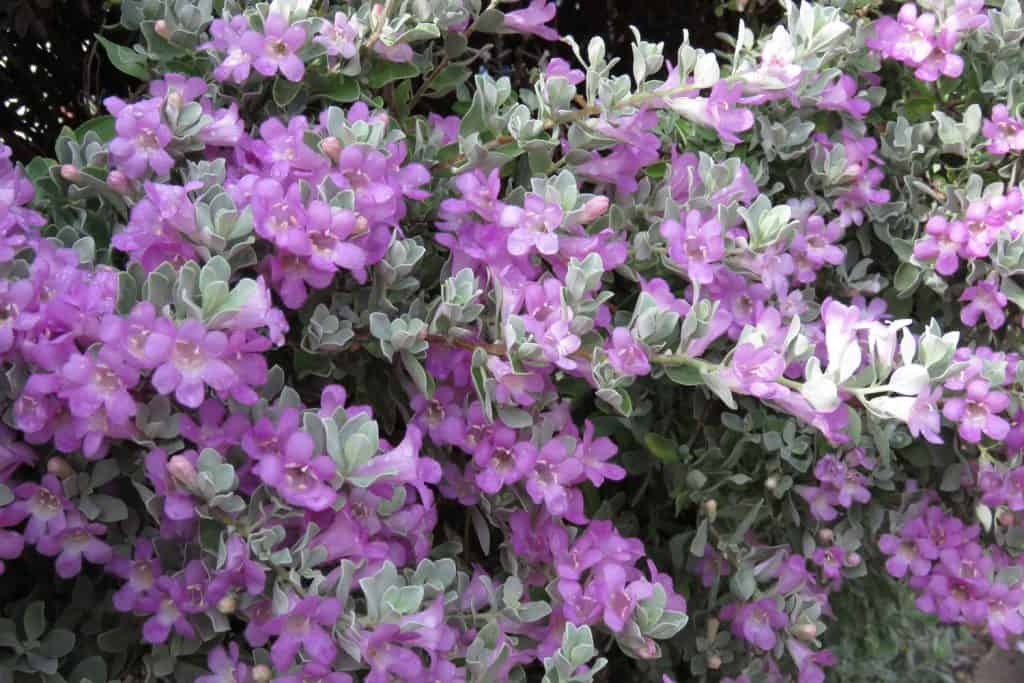
Texas Sage, also called Cenizo, is a perennial shrub in the Figwort family. This shrub is native primarily to the desert regions of Texas and Mexico, is very easy to grow in clay soil, and can tolerate both heat and cold water. You can also plant Texas Sage in a sunny spot or partial shade and don't need to give it too much water.
On top of that, Texas Sage can bloom all year, usually after several days of rain showers, hence it being nicknamed the barometer bush. Its bloom color can range from white to pink to purple, and the leaves are silver or a bluish-gray. The shrub itself usually grows between 4-8 feet tall, so this shrub can get pretty big.
8. Evergreen Sumac (Rhus virens)

The Evergreen Sumac, sometimes called the Tobacco Sumac, is a flowering shrub native to central Texas, Arizona, and New Mexico. It has high drought tolerance and thrives best in dry soil with little water. It will typically grow up to ten feet tall, depending on how you prune it.
Evergreen Sumacs also produce small, fragrant blooms that are white or pale yellow. It blooms in July and August and produces small red-orange berries in the fall. This is a great plant for attracting butterflies and birds to your garden, so we recommend it.
9. Fragrant Sumac (Rhus aromatic)
The Fragrant Sumac is in the same family as the Evergreen Sumac above. It can be grown in places other than Texas and most soils, including clay. This plant species is also great for sunny and shady gardens, so it should work in almost any location. On top of that, the Fragrant Sumac also does best with very little water, perfect for Texas's drier regions.
Fragrant Sumacs are also larger than the Evergreen Sumac and can grow anywhere from five to 12 feet tall. Their blooms are typically yellow, appear from April to June, and then turn into red berries during fall.
10. Texas Mountain Laurel (Sophora secundiflora)
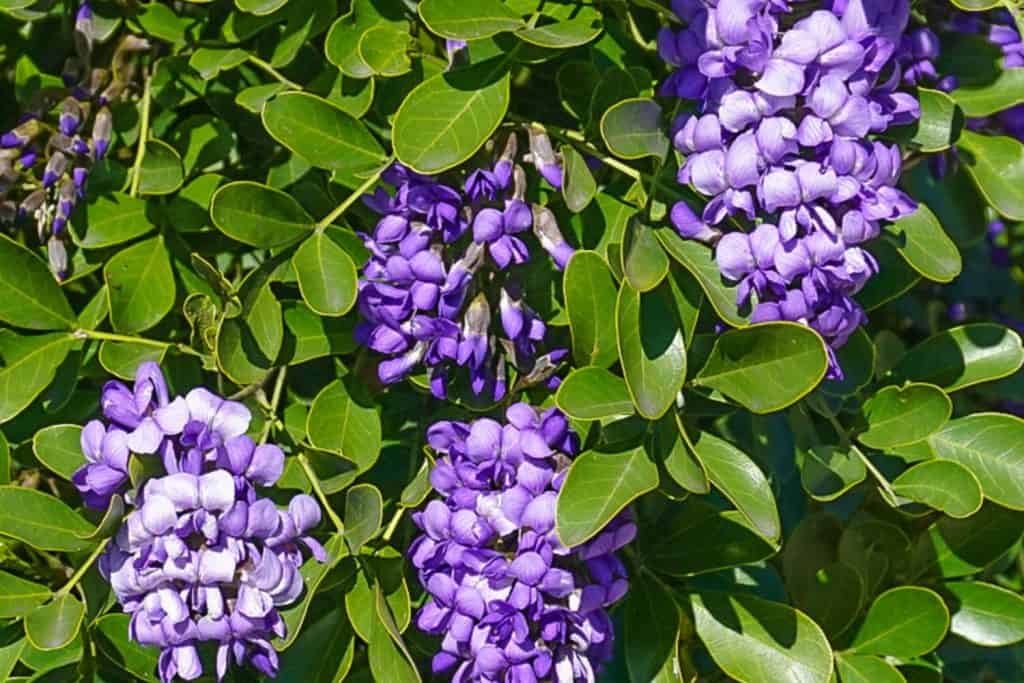
Although there are different species of Mountain Laurel all over the United States, the Texas Mountain Laurel is native to Texas and New Mexico. It grows well in clay soil but needs good drainage and can tolerate dry and moist conditions. It also does well in sunny and partly shady locations, so you can plant it in almost any garden.
The Texas Mountain Laurel blooms earlier than most of the other plants on this list, usually around February and March. This particular species produces bluish-purple flowers. The foliage is evergreen when it isn't in bloom, so you'll see some color from this plant all year. We should note that this isn't a tiny plant; it's a tree that can grow up to 20 feet tall.
11. Wax Myrtle (Morella Cerifera)
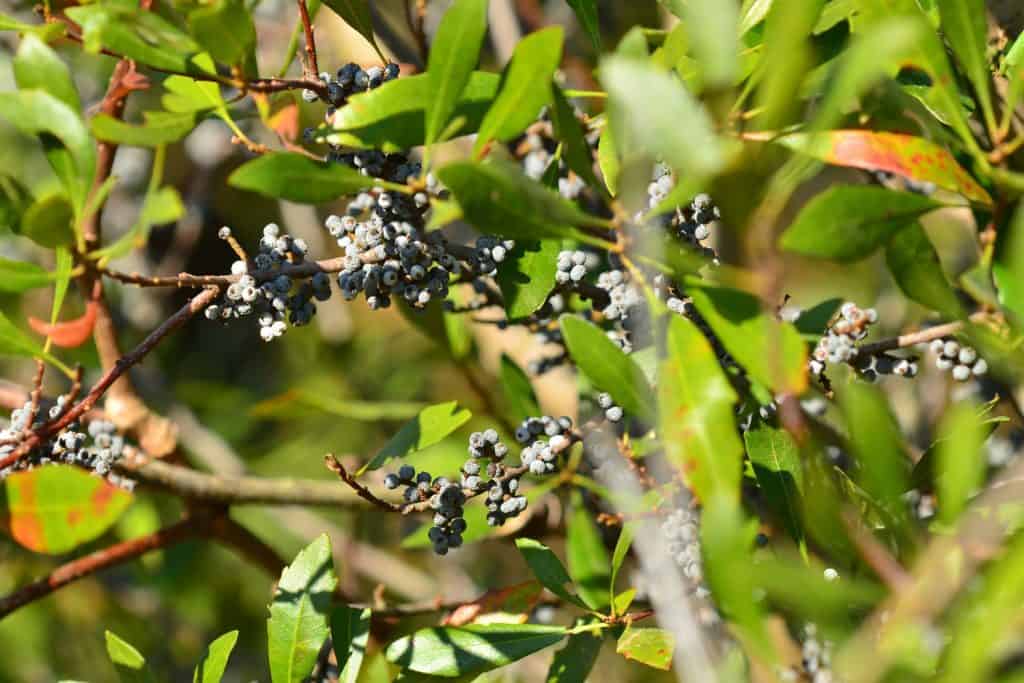
The Wax Myrtle, also known as the Bayberry or Candleberry tree, is native to Texas and most of the Southeastern U.S. It grows well in clay soil but requires a lot of water while getting established but can be drought tolerant once it reaches maturity. It also does well in full sun and even partial shade.
That said, Wax Myrtles produce green-colored berries around March and April. The berries can be melted down for candle wax or eaten by birds. Wax Myrtles will also get up to 40 feet tall, although many don't get bigger than 12 feet.
Final Thoughts
We tried to provide a variety of plant types that can grow under different conditions. Hopefully, this article provided you with some great options for plants you can grow in clay soil if you live in Texas and will lead you one step closer to the garden of your dreams.
Before you go, check out these helpful related posts below!
